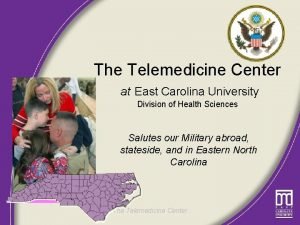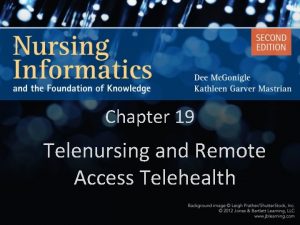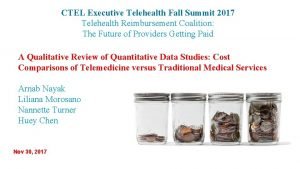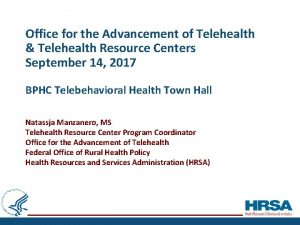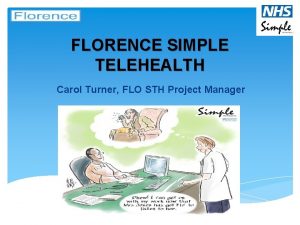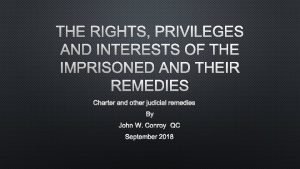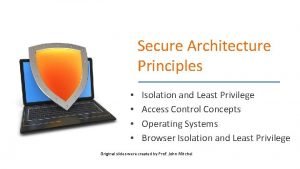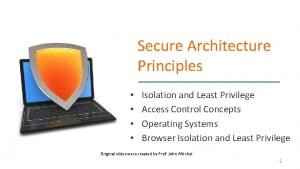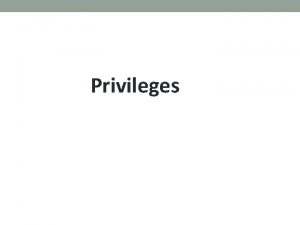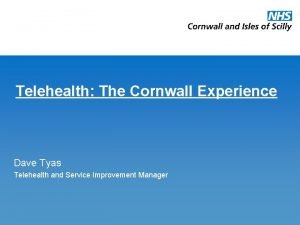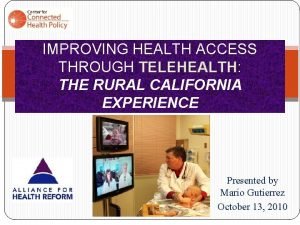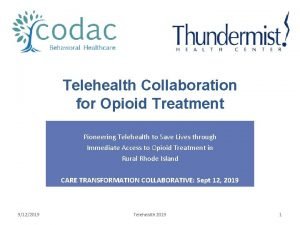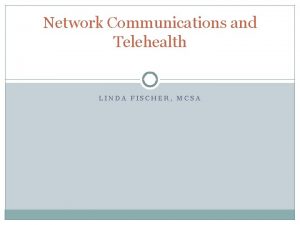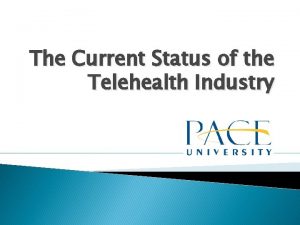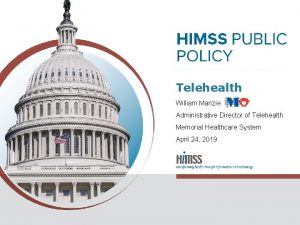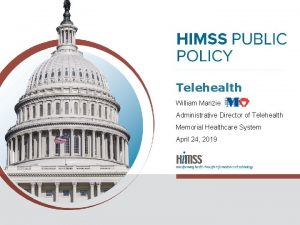Telehealth Education for Privileges Telehealth Strategy Mission To















- Slides: 15

Telehealth Education for Privileges

Telehealth Strategy Mission: To integrate Telehealth practice into the clinical workflow of patient care in connecting providers and patients to provide quality, convenient and efficient care across the Stony Brook Health System and Beyond Telehealth Clinical Excellence Telehealth Regional Standing Patient. Centered Care Community Leader Academic & Research Excellence Our Values → ICARE: Integrity, Compassion, Accountability, Respect, Excellence

Privileging Telehealth practice aligns with your clinical privileges • Current credentialing and licensing for telehealth follows medicine credentialing and licensing laws • There is no “National” Medical License • You can only provide telehealth services for the medical practice you are credentialed and licensed to perform • Utmost professional behavior and appearance must be adhered to in Telehealth practice • Telehealth practice is defined by where the PATIENT is and can only be delivered to a patient in a state where you are licensed to practice

Know the Rules • Physicians Practice Under State Licenses (New York) and must abide by New York State Law • CMS or Medicare policies are dictated by Federal Law (Federal Register) and Reimbursement is written in the Physician Fee Schedule • Clinicians must be knowledgeable about Both and Make sure not to Violate either • It is best practice to ask Compliance (Especially before performing new services/ billing new codes)

Definitions Telemedicine Telehealth • The delivery of clinical health care services by means of real time two-way electronic audio-visual communications • The use of electronic information and communication technologies to deliver health care services • Facilitate the assessment, diagnosis, consultation, treatment, education, care management and self-management of a patient's health care • Includes the assessment, diagnosis, consultation, treatment, education, care management and/or self-management of a patient. • Patient is located at a separate “originating” site and the health care provider is at a distant site • Does Not include delivery of services by means of audio-only telephone communication, fax, or electronic messaging alone, • Can be used in conjunction with telemedicine, store and forward technology or remote patient monitoring. NY Consolidated Law Service Public Health Sec. 2805 -u. NY Public Health Law Article 29 – G Section 2999 -cc

Scope Telehealth and Telemedicine are Often Used Interchangeably • Both describe the use of medical information exchanged via electronic communications to improve the patients’ health status • Telemedicine is usually associated with direct patient clinical services • Telehealth is usually associated with a broader definition of remote health care services Telehealth Telemedicine What Telehealth/Telemedicine Is Not: • Radiology Standard Practice (i. e. Remote Chest X ray/ MRI reads) • A substitute for critical patients requiring an In-person evaluation

Sites and Hub and Spoke “Distant site” means a site at which a telehealth provider is located while delivering health care services by means of telehealth. “Originating site” means a site at which a patient is located at the time health care services are delivered to him or her by means of telehealth. Originating sites shall be limited to: (a) facilities licensed under articles twenty-eight and forty of this chapter; (b) facilities as defined in subdivision six of section 1. 03 of the mental hygiene law; (c) certified and non-certified day and residential programs funded or operated by the office for people with developmental disabilities; (d) private physician’s or dentist’s offices located within the state of New York; (e) any type of adult care facility licensed under title two of article seven of the social services law; (f) public, private and charter elementary and secondary schools, school age child care programs, and child day care centers within the state of New York; and (g) the patient’s place of residence located within the state of New York or other temporary location located within or outside the state of New York. https: //www. nysenate. gov/legislation/laws/PBH/2999 -CC Spoke Originating Site Hub Distant Site Spoke Originating Site Hub - The provider providing telehealth consultation Spoke - The patient receiving telehealth services

Classifications Asynchronous (Store and Forward) • • Patient or physician collects data: medical history, images, pathology, reports and then sends it to a specialist physician for diagnostic and treatment expertise Store and Forward can be done through a Patient Portal, electronic messaging, or through special software This is popular with specialists for example in Dermatology and Ophthalmology , among others Usually omits Standard Radiology Practices (Remote reading of an Xray) Remote Patient Monitoring (RPM) • • • Remote patient monitoring (RPM) uses digital technologies to collect medical and other forms of health data from individuals in one location and electronically transmit that information securely to health care providers in a different location for assessment and recommendations. This type of service allows a provider to continue to track healthcare data for a patient once released to home or a care facility, (often reducing readmission rates or need for emergency room visits) Monitoring programs can collect a wide range of health data from the point of care, such as vital signs, weight, blood pressure, blood sugar, blood oxygen levels, heart rate, and electrocardiograms. Mobile Health (mhealth) • Mobile health, or m. Health, is a rapidly evolving aspect of technology-enabled health care. • Smart phones and portable monitoring sensors that transmit information to providers, as well as dedicated application software (apps) which are downloaded onto devices, are used in m. Health. Given its recent emergence into the telehealth field, policies governing the use of this technology are continually being shaped. • The Food and Drug Administration (FDA), the Federal Trade Commission (FTC), and the Federal Communication Commission (FCC) all share jurisdiction over some part of the federal regulation of m. Health. From: Center for Connected Health Policy: The National Telehealth Policy Resource Center

Medicare Definitions Are Unique

Steps You Must Take Only provide telehealth services for the medical practice you are credentialed and licensed to perform! • Utmost professional behavior and appearance must be adhered to in Telehealth practice • “Webside Manner” instead of Bedside Manner • Ensure proper lighting and be attentive to what is in your background that the patient will see • Practice warm and cordial virtual communication techniques • Make sure you have the patient MRN, name, and other patient details available to you before starting the encounter (The Video software is not linked to the EMR, therefore prepare for proper documentation on the right patient in advance). • Ask for the Patient’s Consent verbally to have a telehealth visit and document the patient’s approval • Document in your note that you used Live-Two-way Audio and Visual to evaluate the Patient

Data Security and Safety HIPAA (Health Insurance Portability and Accountability Act) o Patient data must be secure at all times o Remote Patient Monitoring may limit confidentiality Firewalls must ensure security Telehealth providers must abide by patient safety laws Consent is required for accessing patient data o Written or electronic consent often needed ex: Health Information Exchanges

Patient Confidentiality/Consent • Obtain written permission from the patient before transmitting any protected health information • Document names, credentials, organizational affiliations and locations of the various health professionals involved in Telehealth activity • Require all staff involved in the Telehealth encounter to execute confidentiality agreements • Make sure to describe and document that you discussed the potential benefits and risks of a Telehealth encounter • Allow only designated professionals to disclose health related information • Explain to the patient how care is to be documented and accessed • Transmit patient/client data on an as-needed basis • Schedule telehealth encounters in a room that is suitably enclosed or private • Ensure the patient/client is aware and grants approval for all personnel participating in the consultation • Discuss with the patient a contingency plan in the event of a problem during the procedure (loss of connectivity etc. ) • Prohibit the use of unauthorized cameras and cellular telephones in the examination room • Document the names of those responsible for ongoing care • Re-iterate the right for the patient to revoke consent and to seek in person care. • Mandate HIPAA practices

Final Notes Not All Telehealth Practice will be Reimbursable o Discuss billing strategy with your administrator Must Discuss Any Implementation with Department Administrator Must Adhere to Any Additional Organizational, Regulatory, or Accreditation o Requirements Necessary by Department Inform Compliance Before Use and Consider Getting Training

Resources Northeast Telehealth Resource Center for Connected Health Policy http: //netrc. org/new-york/ http: //www. cchpca. org American Telemedicine Association New York State Department of Health http: //thesource. americantelemed. org/home https: //www. health. ny. gov Middle Telehealth Resource Centers for Medicare and Medicaid Services http: //www. matrc. org/general-telehealth-resources https: //www. cms. gov Stony Brook Medicine Telehealth Policy #LD 0112

ATTESTATION • • • I attest that I have reviewed and understand the Telehealth Education for Privileges presentation. ___________________ PRINTED NAME ______________ SIGNATURE • • ___________________ DEPARTMENT _________ DATE • • EMAIL: medical_staff_office@stonybrookmedicine. edu FAX: 631 -706 -3002 RETURN THIS COMPLETED FORM TO THE MEDICAL STAFF SERVICES DEPT
 Telehealth and telemedicine
Telehealth and telemedicine Telenursing and remote access telehealth
Telenursing and remote access telehealth Ctel telehealth
Ctel telehealth Office for the advancement of telehealth
Office for the advancement of telehealth Flo telehealth
Flo telehealth Rights vs privileges
Rights vs privileges Membership has its privileges
Membership has its privileges Workplace manager privileges chapter 14
Workplace manager privileges chapter 14 Federalism
Federalism No state can make unreasonable distinctions
No state can make unreasonable distinctions Rights vs privileges
Rights vs privileges Rights vs privileges
Rights vs privileges Rights and privileges
Rights and privileges Weakness in isolation, privileges
Weakness in isolation, privileges Weakness in isolation privileges
Weakness in isolation privileges Full faith & credit vs. privileges & immunities
Full faith & credit vs. privileges & immunities
